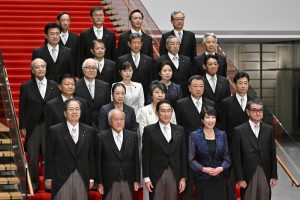On September 13, Japanese Prime Minister Kishida Fumio reshuffled his Cabinet, tapping a record-tying five women as ministers and replacing the ministers of defense and foreign affairs.
It is highly likely that the reshuffle was conducted in response to the Kishida administration’s sluggish support rates, which have been hovering in the 30 percent range in the latest polls.
In the short term, the approval rating may rise due to the Cabinet shake-up. But Kishida’s political future is unpredictable in the medium to long term, as his faction is the fourth largest within the ruling Liberal Democratic Party (LDP). Support from the other factions will be crucial to his bid for re-election as the LDP’s president in the fall of 2024.
Kishida also may face difficulties in determining the optimal timing for dissolving the lower house vis-a-vis the LDP presidential race. The next election must be held by the end of October 2025.
The biggest factor behind the Kishida Cabinet’s declining approval ratings has been the introduction of the “My Number” national identification card system, which has raised public skepticism over privacy and network security. Public frustration over rising prices of imported energy and goods, accelerated by a weaker yen, helped drag down popular support.
A series of alleged scandals involving Deputy Chief Cabinet Secretary Kihara Seiji, a close aide to Kishida, have also diminished the premier’s approval ratings.
Out of 19 ministers, the new Cabinet lineup included 11 first-timers, six holdovers, and two people who served in previous Cabinets.
The reshuffle brought a change of key cabinet ministers, including the appointment of Kamikawa Yoko as Japan’s new foreign minister and Kihara Minoru as new defense minister, replacing Hayashi Yoshimasa and Hamada Yasukazu, respectively.
Most notably, it was surprising to see Kishida relieve Hayashi, who just met Ukrainian President Volodymyr Zelenskyy in Kyiv on September 9 and agreed to begin discussions on security guarantees and cooperate on reconstructing Ukraine’s economy. Hayashi was widely expected to preside over the G-7 foreign ministers’ meeting, scheduled for this fall in Japan.
Asked why Hayashi was replaced by Kamikawa, Kishida said at a press conference on September 13 that there are many talented people in charge of foreign affairs within the ruling LDP and that he wants to provide opportunities for them to demonstrate their abilities.
“Of course, Mr. Hayashi is extremely talented, but I believe that creating a system in which talented people within the party can demonstrate their abilities is also meaningful in moving diplomacy forward,” Kishida said.
New Foreign Minister Kamikawa, 70, is known as the “Iron Lady.” Having served as justice minister three times, she ordered 16 executions, the most of any justice minister. In particular, in 2018, she ordered the execution of 13 former Aum Shinrikyo cult members in connection with the 1995 sarin gas attack on the Tokyo subway system.
After graduating from the University of Tokyo, Kamikawa joined the Mitsubishi Research Institute, a Japanese think tank, and studied at Harvard University’s Kennedy School of Government. Before entering politics, she also worked as a policymaking staffer for then U.S. Senator Max Baucus and founded a public policy consulting firm.
Notably, Kamikawa places great importance on Japan-South Korea relations. “If we can continue dialogue, it is entirely possible to overcome past wrongs,” Kamikawa said at the 400th Anniversary Symposium of the Korean Envoy held in Shizuoka City in 2007. Kishida may believe that Kamikawa was the right person to advance Japan-South Korea relations, which are currently blossoming after an icy period during 2017-2022.
Kamikawa is the first woman to serve as Japan’s foreign minister since Kawaguchi Yoriko held the post from 2002 to 2004.
New Defense Minister Kihara, 54, served as parliamentary vice minister of defense from September 2013 to September 2014. He also served as special adviser to the prime minister in charge of national security from September 2019 to October 2021.
Asked about Kihara, Kishida said at the press conference, “He is an expert in this field [of national security].”
Kishida retained Digital Transformation Minister Kono Taro and Economic Security Minister Takaichi Sanae in the new cabinet. With the LDP presidential election coming up in the fall of 2024, Kishida has brought strong candidates who could challenge his re-election bid into his Cabinet. Both Kono and Takaichi ran against Kishida for the LDP presidency in the last party election in September 2021.
In Japan, most Cabinet reshuffles take place in September, largely due to the legislative calendar. Japan’s Diet normally has two regular sessions per year: one from January to June and another from September to December. Cabinet reshuffles are usually carried out before or after a session of the Diet, and thus are often carried out in September, when the first half of the regular session of the Diet has ended and the government is formulating new policies and political directions.

































